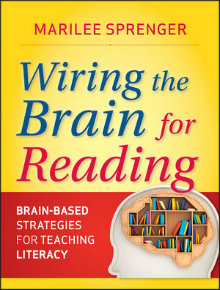The Brain-Literacy Connection
Wiring the Brain for Reading:
Brain-Based Strategies for Teaching Literacy
By Marilee Sprenger
(Jossey-Bass/Wiley, 2013 – Learn more)
I realized from reading this book that I’m not as interested in how the brain works as in how brain research can inform my teaching in the upper elementary grades.
If you want to know, in detail, how the brain works – or if you work or parent very young children (pre-K) – the first three chapters of this book will especially interest you. Chapter One focuses on language development. Subtopics include The Right Way to Babble, Encouraging Speech, Ages and Stages in Language Development and ends with some common sense activities (e.g., for ages 4-6: make sure you have the child’s attention before you speak; from ages six on: talk and read to your child.)
Being a stickler for details, I noticed that at one point the author states that there are 6,000 languages in the world (p. xiv) and three pages later, states that there are 7,000 languages in the world (p. 2). Since I work with children from all over the world, it left me wondering how many languages there are in the world.
Neural Research

In this chapter, Sprenger also states that various intervention methods can rewire the brains of some struggling readers and dyslexic readers for reading (p. 32). As an elementary teacher, I found myself just wanting the interventions to start being discussed, but that didn’t start until chapter 4.
The Brain-Body Connection
Chapter Three brought information about the body-brain connection, including lots of information I was familiar with (e.g. importance of sleep, exercise, a healthy diet.) Again, reading the text as a classroom teacher, I realized that although these were critical components for healthy children, many of these things were out of my teacher control – especially the amount of sleep my students received (and this IS a big issue in our school).
Activities for Struggling Readers
Phonemic awareness is the topic of Chapter 4. The author states what I have noticed as well: “It is also important that teachers be aware that struggling readers may lack phonemic awareness” (p. 95). Sprenger ends this chapter with a dozen activities designed to assist children (young and older students) in learning the sounds of the letters. I realized that this is what I was looking for – activities to support my struggling readers that were based on current brain research.
Phonics, fluency, vocabulary, and comprehension are the topics for chapters 5-8. Sprenger shares the research and then concludes the chapters with activities that both parents and teachers could use to support students. I suspect parents would find these activities more unique than teachers since most are common practices in classrooms in my district (e.g., vocabulary word maps, KWL charts, cloze assessments, word walls, reciprocal teaching, and question-answer or QAR strategy.)
The author concludes by stating: “The most important piece of the learning puzzle is the relationships in children’s lives. Work on your relationship with every child and help them form strong relationships that include face-to-face time.” Great advice for teachers and parents of readers of all ages.
_____________________
Julie Dermody, NBCT, is currently an upper elementary ESL teacher in the Chapel Hill-Carrboro (NC) City Schools. She has also served as an elementary, middle and high school teacher, a reading specialist and a teacher of gifted students. Her article about ESL students, “Going for the Growth,” appeared in the September 2012 Educational Leadership (online edition). Julie recently presented at TESOL’s International Convention in March 2013 in Dallas, Texas. She writes and reviews regularly for MiddleWeb.




































